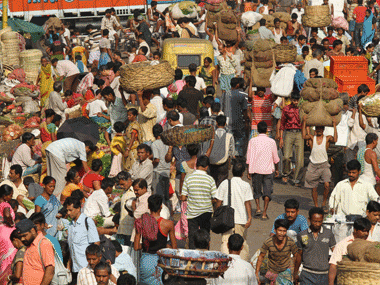The good south-west monsoon this year has given at least one reason to cheer - higher agriculture production. The government has said that agriculture production will surpass last year’s numbers, making it the second consecutive year of strong agriculture growth.
While it is indeed a happy trend, at a time when the economy is seeing flagging industrial production and high price pressures, the information needs to be interpreted with caution.
Reason: given the volatility in agriculture production, it is often one step forward, two steps backward. As a result, there is little growth over time in the sector - foodgrain production has grown at a compounded annual growth rate (CAGR) of 1.3 percent.
In 2001-02, food grain output was at 212.9 million tonnes, compared with 241.6 million tonnes in 2010-11.
[caption id=“attachment_114373” align=“alignleft” width=“380” caption=“There has been a fundamental mismatch between agricultural and population growth rates. Reuters”]  [/caption]
If you are wondering why food prices are rising despite a record harvest, it lies in these numbers. There has been a fundamental mismatch between agricultural and population growth rates. While agricultural growth had a CAGR of 1.3 percent over the decade, population growth had a CAGR of 1.64 percent.
This explains why food prices are structurally unresponsive to the odd year or two of good harvests. It also suggests that till we improve agricultural productivity, food inflation will be a persistent problem.
Of course, one can say that CAGR is dependent on the base year itself, and if we look at a ‘drought’ year instead of a ’normal’ year, the figures might look better (though that is really a statistical fallacy).
Even from the lowest production during the past decade - that of 175 million tonnes during 2002-03, foodgrain output does not show impressive growth. The CAGR up to 2010-11 remains subdued at less than 4 percent rates.
In fact, even during 2010-11, when foodgrain output rose by around 11 percent over the previous year, it was not really a genuine representation of growth, since the base was low. In 2009-10, agricultural production had declined by around 7 percent. Had it continued to rise during the year, foodgrain production in 2010-11 might have looked less than stellar.
[caption id=“attachment_114366” align=“alignleft” width=“600” caption=“Table”]  [/caption]
It is well known that India is a story driven by services, and then industry. Agriculture comes last. In fact, agriculture is the one sector that is a drag on the India growth story. With rising incomes it is important that India’s food output demands are met in order to ensure inflation stays in check.
However, over the past decade, there has been particularly little growth in staple foods’ output. Rice, for instance, has grown only by 0.2 percent over the years and wheat has shown growth of 1.7 percent. While coarse cereals and pulses have performed slightly better, their output, too, is lagging significantly behind other sectors like industry and services.
For India to continue its high growth rates, it is important that foodgrain production catches up, else chronically high food prices can seriously dent the India growth story.


)
)
)
)
)
)
)
)
)



